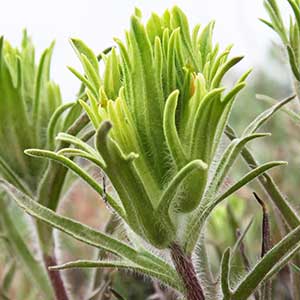Castilleja subinclusa
Castilleja oresbia
Franciscan paint brush, longleaf Indian paintbrush
pale paintbrush, pale Wallowa Indian paintbrush, pale Wallowa paintbrush
solitary or few to many, erect to ascending, often leaning on nearby shrubs (var. jepsonii), unbranched or branched, often with small, leafy axillary shoots, hairs matted to spreading, short and long, soft, mixed with short stipitate-glandular ones.
few to several, erect or ascending, sometimes decumbent at base, unbranched or branched, hairs usually retrorse, medium length, ± soft, eglandular, mixed with very short-glandular ones, sometimes with spreading, long, soft ones.
green, pale gray-green, sometimes dull reddish purple, linear to narrowly, sometimes broadly, lanceolate, 2–10.5 cm, not fleshy, margins plane, sometimes ± wavy, flat or involute, 0(–3)-lobed, apex acuminate to acute;
lobes spreading, linear to short-lanceolate, often arising near mid length, apex acute to obtuse.
green to purple, linear to lanceolate, 2–7 cm, not fleshy, margins plane, involute, 3–5(–7)-lobed, apex acuminate to acute;
lobes spreading, linear to sometimes narrowly lanceolate, apex acute.
3–30 × 1–7 cm;
bracts green or dull purple throughout, or proximally green or dull purple, distally bright red to orange-red, sometimes salmon, orange, or yellow, usually linear to lanceolate, distal sometimes broadly lanceolate to oblong or elliptic, 0(–3)-lobed;
lobes spreading to erect, linear to oblong or triangular, short or medium length, arising near or above mid length, apex acute to obtuse.
2.5–18 × 1–3.5 cm;
bracts pale green to yellow-green or pale, dull reddish brown throughout, or proximally so colored but changing gradually to cream or yellowish on distal margins, narrowly to broadly lanceolate, (3–)5–7(–9)-lobed;
lobes ascending, linear, long, proximal lobes arising below mid length, central lobe apex obtuse, others acute.
curved proximally, straight to slightly curved distally, 25–57 mm;
tube 15–29 mm;
beak subequal to or exceeding calyx but abaxial lip, beak, and often part of tube usually exserted out abaxial cleft;
beak adaxially green, yellow-green, or yellow, 13–21 mm, margins red, orange, or yellow;
abaxial lip green, yellow, reddish, blackish, or deep red-purple, reduced, protuberant, forming a platform, 1–2 mm, 5–25% as long as beak;
teeth ascending, green, purple sometimes with reddish tip, yellow, or blackish, 0.5–1 mm.
straight, 21–36 mm;
tube 16–20 mm;
teeth of abaxial lip often exserted, beak exserted;
beak adaxially green, 4.2–5.5 mm;
abaxial lip green to purple, distally white, conspicuous, slightly but noticeably pouched, often visible through front cleft, 3–5 mm, 67–100% as long as beak, puberulent;
teeth erect, white, 1.8–2.1 mm.
proximally pale green, rarely pale purple, distally bright red or red-orange, rarely orange or yellow, or bright red or red-orange throughout, 20–42 mm;
abaxial clefts 13–27 mm, adaxial 7–17 mm, abaxial 40–70% of calyx length, adaxial 12–33% of calyx length, deeper than laterals, lateral 0–7.5 mm, 0–35% of calyx length;
lobes linear to narrowly triangular, strongly curved away from stem proximally and distally obviously curved toward stem, apex acute to acuminate to obtuse.
colored as bracts, 10–25 mm;
abaxial and adaxial clefts 6–7 mm, 30–60% of calyx length, deeper than laterals, lateral 5–10 mm, 40–50% of calyx length;
lobes linear, apex acute.
= 24, 48, 72, 96.
Castilleja subinclusa
Castilleja oresbia
Varieties 3 (3 in the flora).
Castilleja subinclusa is divided into three varieties with somewhat discontinuous ranges. Identification of the varieties is often difficult when comparing only a single trait but is more easily accomplished when the characters are considered in a suite. The three varieties are also separable by range and habitat.
(Discussion copyrighted by Flora of North America; reprinted with permission.)
Castilleja oresbia is endemic to eastern Oregon and adjacent Idaho. It is easily confused with both varieties of C. pallescens, which also occur in sagebrush habitats. Castilleja oresbia has longer calyx lobes and softer pubescence than C. pallescens var. pallescens, although some transitional specimens are found. Castilleja oresbia has a combination of longer calyx lobes, longer pubescence, and obscurely nerved bracts, which usually serve to separate it from C. pallescens var. inverta. All three have different, though somewhat overlapping, ranges. Castilleja oresbia occasionally hybridizes with C. peckiana in Grant County, Oregon.
(Discussion copyrighted by Flora of North America; reprinted with permission.)
1. Corolla beaks adaxially bright yellow, sometimes greenish yellow near apex, margins yellow, rarely orange or red, strongly contrasting with color of calyces; stems and leaves greenish, sometimes dull reddish; lateral calyx clefts 0–4 mm; coastal scrub communities; coastal c California. | var. franciscana |
1. Corolla beaks adaxially green to yellow-green, rarely yellow, margins red to orange, rarely yellow, not strongly contrasting with color of calyces; stems and leaves greenish, pale gray-green, or dull reddish; lateral calyx clefts 3–7.5 mm; dry, sandy or rocky slopes, desert scrub, foothill woodlands, chaparral, brushy openings in pine-oak woods; w foothills of Sierra Nevada in c California or sw California. | → 2 |
2. Stems and leaves greenish, sometimes dull reddish; bracts (0–)3-lobed; brushy openings in pine-oak woods; mostly in w foothills of Sierra Nevada in c California. | var. subinclusa |
2. Stems usually dull reddish; leaves usually pale gray-green to ± ash-colored; bracts 0(–3)-lobed; dry, sandy or rocky slopes, desert scrub, foothill woodlands, chaparral; sw California. | var. jepsonii |
